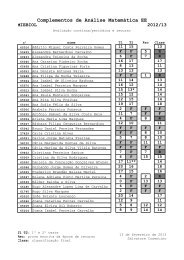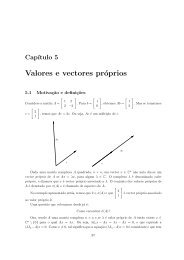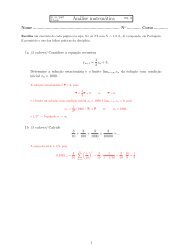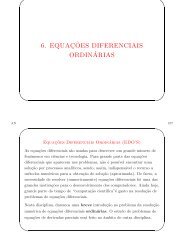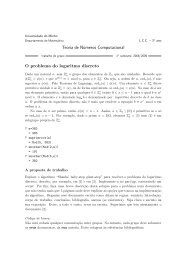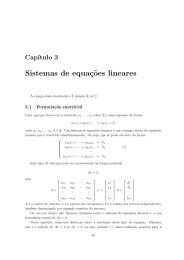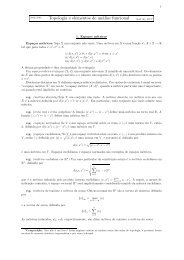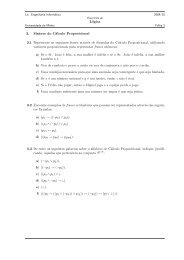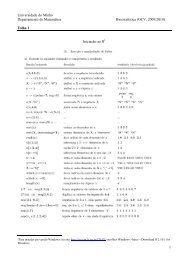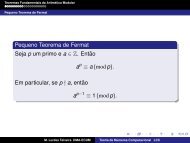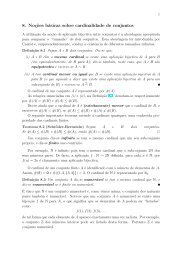My title - Departamento de Matemática da Universidade do Minho
My title - Departamento de Matemática da Universidade do Minho
My title - Departamento de Matemática da Universidade do Minho
You also want an ePaper? Increase the reach of your titles
YUMPU automatically turns print PDFs into web optimized ePapers that Google loves.
10 STATISTICAL DESCRIPTION OF ORBITS 68<br />
for any (boun<strong>de</strong>d) continuous function ϕ : X → R. The space C 0 (X, R) of boun<strong>de</strong>d continuous real<br />
valued functions on X, equipped with the sup norm, is a separable Banach space. In particular,<br />
it admits a countable set of points {ϕ n } n∈N<br />
which is <strong>de</strong>nse in its unit sphere. Given that, one<br />
<strong>de</strong>fines, for any couple of Borel probability measures µ and ν, a distance<br />
∞∑<br />
∫ ∫<br />
d (µ, ν) = 2 −n ·<br />
∣ ϕ n dµ − ϕ n dν<br />
∣<br />
n=1<br />
It turns out that d is in<strong>de</strong>ed a metric, and that it induces the weak ∗ topology on Prob. The<br />
important fact (somewhere called ”Helly’s theorem”), which follows from the Ascoli-Arzela theorem<br />
together with the above Riesz-Markov representation theorem, is that Prob, equipped with the<br />
weak ∗ topology, is a compact space: any sequence (µ n ) of Borel probability measures admits a<br />
weakly ∗ convergent subsequence µ ni → µ.<br />
Now, we are in position to prove the existence of invariant probability measures for certain well<br />
behaved dynamical systems.<br />
X<br />
X<br />
Krylov-Bogolyubov theorem. A continuous transformation f : X → X of a metrizable<br />
compact space X admits at least one Borel invariant probability measure.<br />
proof. Take any Borel probability measure µ 0 on X, and inductively <strong>de</strong>fine a family of probability<br />
measures µ n by µ n+1 = f ∗ µ n . Consi<strong>de</strong>r the family of Cesaro means<br />
µ n = 1 n∑<br />
µ k<br />
n + 1<br />
Since the space of Borel probability measures on a compact metrizable space is compact w.r.t.<br />
weak ∗ convergence, there exist a weakly ∗ convergent subsequence µ ni<br />
→ µ. One then easily sees<br />
that<br />
∫<br />
1 ∑n i<br />
∫<br />
(ϕ ◦ f) dµ = lim<br />
(ϕ ◦ f) dµ k<br />
X<br />
i→∞ n i + 1<br />
k=0<br />
X<br />
1 ∑n i<br />
∫<br />
= lim<br />
ϕdµ k+1<br />
i→∞ n i + 1<br />
k=0<br />
X<br />
1 ∑n i<br />
∫<br />
= lim<br />
ϕdµ k + 1 (∫<br />
∫ )<br />
ϕdµ ni+1 − ϕdµ 0 i→∞ n i + 1<br />
k=0<br />
X n i + 1 X<br />
X<br />
∫<br />
= ϕdµ<br />
X<br />
for any boun<strong>de</strong>d continuous observable ϕ, hence that µ is an invariant measure. □<br />
k=0<br />
10.3 Invariant measures and time averages<br />
The relevance of invariant measures when studying the dynamics of continuous transformations is<br />
due to the following crucial observations.<br />
Invariant measures and time averages. Assume that, for a given point x ∈ X, the time<br />
averages<br />
1<br />
n∑<br />
ϕ (x) = lim ϕ ( f k (x) )<br />
n→∞ n + 1<br />
<strong>do</strong> exist for any boun<strong>de</strong>d continuos observable ϕ. One easily shows that the funcional Cb 0 (X, R) →<br />
R <strong>de</strong>fined by ϕ ↦→ ϕ (x) is linear, boun<strong>de</strong>d and positive <strong>de</strong>finite. There follows from the Riesz-<br />
Markov representation theorem that there exists a unique Borel probability measure µ x on X such<br />
that<br />
∫<br />
ϕ (x) = ϕdµ x<br />
X<br />
k=0



